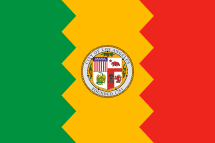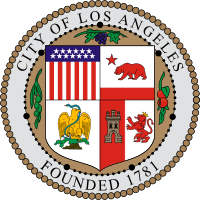Cameron E. Thom
| Cameron E. Thom | |
|---|---|
 Portrait of Cameron E. Thom | |
| 16th Mayor of Los Angeles | |
|
In office December 9, 1882 – December 9, 1884 | |
| Preceded by | James R. Toberman |
| Succeeded by | Edward F. Spence |
| Personal details | |
| Born |
June 20, 1825 Culpeper County, Virginia or Richmond, Virginia |
| Died |
February 2, 1915 (aged 89) Los Angeles, California |
Cameron E. Thom (June 20, 1825 – February 2, 1915) was a lawyer, a legislator, a Confederate officer in the Civil War and the 16th mayor of Los Angeles, California, from 1882 to 1884.
Personal
Thom was born in Culpeper County, Virginia, or in Richmond, Virginia, on June 20, 1825, the son of John Thom, who had been an officer in the War of 1812 and for 30 years was a Virginia state senator. Cameron was educated in private schools in Virginia and was graduated from the University of Virginia, where he earned a law degree.[1][2]
After university, Thom traveled west in a caravan of some 40 young men and arrived in Sacramento in 1849. He gathered gold on the South Fork of the American River, in Amador County, then settled in Sacramento to open a law office. Thom served in the Confederate Army during the Civil War. He was wounded at the Battle of Gettysburg and ended the war as a captain.[1]
Thom was married twice, first in 1858 to Susan Henrietta Hathwell, and then, after Susan's death in 1862, to her sister, Belle Cameron Hathwell, in 1874. He had four children, Cameron DeHart, Charles Catesby, Erskine Pembroke and Belle (Mrs. Arthur Collins of London, England).[1]
Thom died on February 2, 1915, at the age of 89.[2] A funeral service in his home at 2070 West Adams Street attracted a "company of several hundred persons," including representatives of the Society of Colonial Wars, of which he was a founder and charter member. Interment was in Evergreen Cemetery, Los Angeles.[3]
Vocation
Thom arrived in California in 1849 during the gold rush and after a few years of successful mining, he studied law in Sacramento. In fall 1853 he moved to San Francisco, where he worked as a deputy agent for the United States Land Commission, and then to Los Angeles, where he had a similar job. Shortly after arriving, he was appointed Los Angeles County district attorney, and he later won the office in an election. He was also elected Los Angeles city attorney for the 1856-58 term.[1][4]
In 1859–60 Thom was |state senator from California's 1st State Senate district, and he was Los Angeles County district attorney from 1854 to 1857, from 1869 to 1873 and from 1877 to 1879. He was mayor of Los Angeles from 1882 to 1884,[5] and he was on the Board of Freeholders that framed the first city charter for L.A.[1]
Upon his arrival in Los Angeles, Thom purchased a parcel located on the east side of Main Street where Third Street had been laid out by Edward Ord in 1849. There was an existing house that had been constructed a few years earlier by Captain Jesse Hunter, formerly of the Mormon Battalion. The walls of that house were constructed of brick and it was the first such building in Los Angeles - with no use of adobe. In 1860, Thom had a duplicate house constructed immediately to the south for the express use of U.S. Army Captain Winfield Scott Hancock, who commanded federal troops in the southern portion of the state and served as quartermaster as well. Captains Lewis Addison Armistead and Richard Brooke Garnett served under Hancock's command, were assigned to various posts along the Colorado River. Being natives of the south, Armistead and Garnett returned to L.A. following the outbreak of the Civil War, resigned their commands and officer appointments and departed the city. A great Civil War legend has had it that Winfield and Almira Hancock held a farewell reception one evening at their residence for the departing southerners, mid-June of 1861. Cameron Thom, Winfield Hancock, Armistead and Garnett all were engaged in opposition at Gettysburg. And it was Armistead who led his troops over the stone wall, the famous 'High Water Mark' of the Confederacy. His troops were at the forefront of Pickett's Charge - attacking the U.S. Army's Second Corps on Cemetery Ridge, commanded by Hancock. The legend was effectively incorporated in Michael Shaara's book 'The Killer Angels' for which he was awarded a Pulitzer Prize. As well, the legend was faithfully included in the 1993 film 'Gettysburg'. Thom was only an official volunteer in the Confederate Army. He had returned east during the spring of 1863 and his family's influence in Richmond gained him his appointment. He had left Virginai during the California Gold Rush. Deep research by military historian George Stammerjohan and landscape architect John Crandell has revealed that the legend has been a myth, that Garnett and Armistead were not together in Los Angeles in June of 1863, that Garnett had already departed for the south and that Armistead was still in command of troops in San Diego. The legend could only have been concocted by Almira Hancock in 1886 following Winfield's death, published in a memoir after she had destroyed all of her husband's papers. W.S. Hancock was interred with the remains of his daughter in a mausoleum in his hometown - Norristown, Pennsylvania. Mrs. Hancock made arrangements for herself and upon her death, her remains were transported to St. Louis and interred within her family's plot (Russell family). When she and Winfield ('The Hero of Gettysburg' and 1880 Democratic presidential candidate) lived in Los Angeles, the wives of officers under Hancock's command referred to Mrs. Hancock as 'the ice queen'.[6]
City of Glendale
The land case known as "The Great Partition" of 1871 resulted in the division of Rancho San Rafael into thirty-one sections which were given to twenty-eight different people including 724 acres (2.93 km2) for Thom. The land belonging to Prudent Beaudry, Alfred Chapman, Andrew Glassell and Thom evolved into Glendale. Thom, Harry J. Crow, and Thom's nephew, Erskin B. Ross, along with B. F. Patterson and B. T. Byram, were responsible for the creation of the city of Glendale in 1887.[7]
References
- 1 2 3 4 5 Clare Wallace, Los Angeles Public Library reference file, 1938, with sources as listed there
- 1 2 "Useful Hands, Brain Stilled," Los Angeles Times, February 3, 1915, page II-3
- ↑ "Sweetly Sleeps in Evergreen," Los Angeles Times, February 5, 1919, page II-1
- ↑ Chronological Record of Los Angeles City Officials 1850–1938, Municipal Reference Library, March 1938, reprinted 1946
- ↑ Michael Parish, For the People—Inside the Los Angeles County District Attorney's Office ISBN 1-883318-15-7, quoted at Los Angeles County District Attorney Office website
- ↑ 'chapter 4: 'Homage To Downtown ~ In Search of Place and Memory in Ancient L. A.', 2010, Visions of L.A. publisher.
- ↑ John Calvin Sherer, 1922, History of Glendale and Vicinity, The Glendale Publishing Company (1922)
| Political offices | ||
|---|---|---|
| Preceded by David B. Kurtz |
California's 1st State Senate district 1859—1860 |
Succeeded by Jonathan J. Warner |
| Preceded by Benjamin Eaton Alfred B. Chapman Rodney Hudson |
Los Angeles County District Attorney 1854—1857 1869—1873 1877—1879 |
Succeeded by Ezra Drown Volney E. Howard Thomas B. Brown |
| Political offices | ||
|---|---|---|
| Preceded by Lewis Granger |
Los Angeles City Attorney 1856—1858 |
Succeeded by James H. Lader |

